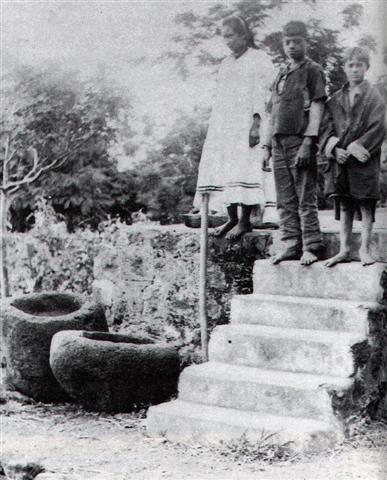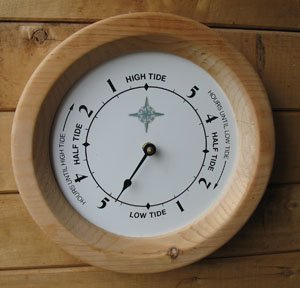Fakataka delivers her child on the upraised reef where there were freshwater pools:
... Fakataka swims and swims, reaching another land. She goes there and stays on the upraised reef in the freshwater pools on the reef, and there delivers her child, a boy child. She gives him the name Taetagaloa. When the baby is born a golden plover flies over and alights upon the reef. (Kua fanau lā te pepe kae lele mai te tuli oi tū mai i te papa).
The upraisede reef means the seawater must have receded after the high tide and that it now was low tide:
The freshwater pools must then have been refilled with rain water, because seawater is salty (vai kava) and opposite in kind to the sweet fresh water. After the high tide it must have rained. Unless in the time of myth when Fakataka delivered her child the sea not yet had become salty:
... Now Frodhi happened to be the owner of a huge mill, or quern, that no human strength could budge. Its name was Grotte, 'the crusher'. We are not told how he got it, it just happened, as in a fairy tale. He traveled around looking for someone who could work it, and in Sweden he recruited two giant maidens, Fenja and Menja, who were able to work the Grotte. It was a magic mill, and Frodhi told them to grind out gold, peace and happiness. So they did. But Frodhi in his greed drove them night and day. He allowed them rest only for so long as it took to recite a certain verse ...
... Snorri Sterluson explains why 'Frodi's grist' is a kenning for gold. Frodi ruled during a peaceful and productive period, contemporaneous with Augustus's Pax Romana and the birth of Christ; hence the kenning. There were neither thieves nor robbers during this period, 'so that a gold ring lay long on Jalang's heath'. Snorri continues his account with the legend of the mill beyond what is told in the song: The girls' grinding produced an army hostile to Frodi. On the very day of the girls' predictions, the sea-king, Musing (Son of the Mouse), landed on the Danish shore, killed Frodi, and took away Grotti and the women on his ship. The girls were bidden to grind out salt on the mill. At midnight they asked for further instructions. 'Keep grinding', he told them. Then they ground with such vigor that the ship sank. Water poured into the eye of the mill, creating the maelstroem of the sea. Therefore the sea was salt. Incidentally, the mill was given a kenning, Serpent's Couch ...
For life up on land the first necessity is to breathe and the next to find fresh water (vai). The glyph type which I have named vai - after having studied where Metoro used this word -
occurs 3 times in line Ca2:
| April 23 |
24 (114) |
25 |
26 |
| October 23 |
24 |
25 |
26 (299) |
 |
 |
 |
 |
| Ca2-7 |
Ca2-8 |
Ca2-9 |
Ca2-10 (36) |
| manu rere |
e tara tua |
tagata oho |
ki te kea |
| θ Arietis (33.3), Mira (33.7) |
no star listed |
ξ Arietis (35.0) |
no star listed |
| 502 B.C. |
573 B.C. |
644 B.C. |
715 B.C. |
| ι Lupi, 18 Bootis (216.3), Khambalia (216.4), υ Virginis (216.5, ψ Centauri (216.6), ε Apodis (216.8) |
Asellus Primus (217.8) |
τ Lupi (218.1), φ Virginis (218.7) |
σ Lupi (219.1), ρ Bootis (219.5), Haris (219.7) |
| April 27 |
28 |
29 |
30 (120) |
| October 27 (300) |
28 |
29 |
30 |
 |
 |
 |
 |
| Ca2-11 |
Ca2-12 |
Ca2-13 |
Ca2-14 (40) |
| tagata oho ki roto o to vai |
kua noho te kea |
kua hua te rima |
tagata oho |
| no star listed |
ν Arietis (38.5) |
μ Arietis (39.4), Head of the Fly (39.6), Kaffaljidhma (39.8) |
ο Arietis (40.0), Angetenar (40.2), Right Wing (40.9) |
| 786 B.C. |
857 B.C. |
928 B.C. |
999 B.C. |
| σ Bootis (220.2), η Centauri (220.4) |
ρ Lupi (221.0), Toliman (221.2), π Bootis (221.8), ζ Bootis (221.9) |
31 Bootis (222.0), Yang Mun (222.1), Rijl al Awwa (222.5), ο Bootis (222.9) |
Izar (223.0), α Apodis, 109 Virginis (223.3) |
| May 1 |
2 |
3 |
4 |
5 (125) |
| October 31 (304) |
November 1 |
2 |
3 |
4 |
 |
 |
 |
 |
 |
| Ca2-15 |
Ca2-16 (42) |
Ca2-17 |
Ca2-18 |
Ca2-19 |
| ki te vai |
erua tamaiti |
ki te huaga o te hoi hatu |
e tagata poo pouo |
| Bharani-2 / Stomach-17 |
no star listed |
ρ Arietis (43.0), Acamar (43.6), ε Arietis (43.7) |
Menkar (44.7) |
3h (45.7) |
| π Arietis (41.2), BHARANI (41.4), σ Arietis, τ² Eridani (41.7) |
Algol (45.9) |
| 1070 B.C. |
1141 B.C. |
1212 B.C. |
1283 B.C. |
1354 B.C. |
| Al Zubānā-14a |
Kochab (225.0) |
Ke Kwan (226.3), Ke Kwan (226.4), Zuben Elakribi (226.8) |
ω Bootis (227.2), Nekkar (227.3), Nadlat (227.8), π Lupi (227.9) |
15h (228.3) |
| ZUBEN ELGENUBI (224.2), ξ Bootis, ο Lupi (224.5) |
Zuben Hakrabim (228.3), λ Lupi (228.9) |
| May 6 |
7 |
8 (128) |
9 |
| November 5 |
6 |
7 |
8 (312) |
 |
 |
 |
 |
| Ca2-20 |
Ca2-21 |
Ca2-22 (48) |
Ca2-23 |
| te vai |
e tino noho toona |
te Rei - pa hia mai |
kiore i te henua |
| Misam (46.2), Botein (46.9) |
ζ Arietis (47.7) |
Zibal (48.0) |
τ Arietis (49.7) |
| 1425 B.C. |
1496 B.C. |
1567 B.C. |
1638 B.C. |
| κ Lupi (229.7), ζ Lupi (229.8) |
Al Zubānā-14b |
μ Lupi, γ Tr. Austr. (231.3) |
ο Cor. Borealis (232.0), δ Lupi (232.1), φ¹, ν² Lupi (232.2), ν¹ Lupi (232.3), ε Lupi (232.4), φ² Lupi (232.5), Pherkad (232.6), η Cor. Borealis (232.8), υ Lupi (232.9) |
| χ Bootis (230.3), Princeps (230.6), ZUBEN ELSCHEMALI (230.8) |
I suggest this type of glyph indeed refers to 'fresh water'. There were no rivers on Easter Island and they collected rain in stone bowls (taheta):

| Moana
Salt water, deep sea, ocean. P Pau.: moana-tekereke, blue. Mgv.: moana, the sea, ocean. Mq.: moana, ocean, high sea. Ta.: moana, sea, ocean, abysmal depth or height, heaven. Churchill. |
| Tai
1. Ocean, sea (often used without an article); he-turu au ki tai hopu, I am going down to the sea to bathe. 2. To be calm, good for fishing: he tai. There exists a surprisingly developed terminology for distinguishing the phases of the tides: tai pâpaku, low tide; ku-gúgú-á te tai, tide at his lowest, literally 'the sea has dried up'; he-ranu te tai, when the water starts rising again; this is a strange expression, since ranu means 'amniotic liquid,' the breaking of the waters which precedes birth; in this phase of the tides the fish start coming out of their hiding places and swim to the coast in search of food; tai hahati, rising tide; tai hini hahati, tide as it continues rising; tai u'a, tai u'a parera, when the tide has reached its high; tai hini u'a, tide all throughout its full phase; tai hori, tide as it starts receding; tai ma'u, tide during its decreasing phase, right until it becomes tai pâpaku again; tai raurau a riki, the slight swell, or effervescence of the sea at a change of the moon. 3. Good spot for raising chickens; the stone chicken coops called hare moa, were built in places 'tai moa'. Ahé te tai o taau moa? whereabouts are the raising grounds of your chickens? 4. Song in general; song executed by a group of singers; ku-garo-ana i a au te kupu o te tai, I have forgotten the words of the song. Taitai, tasteless; said especially of sweet potatoes and other produces of the soil which do not taste good for being too watery; kumara taitai, watery, tasteless sweet potato. Vanaga.
1. Salt water; taitai, brackish, salty. P Mgv., Mq., Ta.: tai, salt water. Mq.: taitai, to salt. Ta.: taitai, salty. 2. Sea, ocean; tai hati, breakers; tai hohonu, depths of the sea; tai kaukau, tide; tai negonego, tide; tai o, ripple; tai parera, tide; tai poko, breakers; tai titi, tide; tai ua, tide, ebb; tai vanaga, ripple. P Mgv., Mq., Ta.: tai, sea, ocean. 3. Ta.: tai-ao, dawn. Mq.: takitaki te ao, just before dawn. Churchill. |
| Vai
Water, liquid, juice. 1. Vai tagata, semen, sperm (also: takatea). 2. Vai kava, saltwater, sea, ocean. Vanaga.
(Sweet) water. Vai-kura = blood. Barthel.
1. Water, liquid, fluid, sap, juice, gravy, fresh water as differing from tai seawater; hakavai to dissolve, to liquefy, to melt. P Pau.: ana-vai, a brook. Mgv.: vai, water. Mq.: vai, water, liquid, juice. Ta.: vai, sweet water, sap, juice. Vaihu (vai-u), milk. T Mq., Ta.: vaiu, milk. Vaipuga (vai-puna), spring water. P Mgv.: vaipuna, water which springs from among stones. Mq.: vaipuna, spring water. Ta.: vaipuna, a spring. Vaitahe (vai-tahe 1), river. 2. Pau.: Vai, to exist. Ta.: vai, to be, to exist. Vaiora, to survive. Sa.: vaiola, the spring 'water of life?' Ma.: waiora, water of life.
Vaitoa (vai-toa 2), sugar. Mgv.: vaito, id. Vaituru (vai-turu 1), water conduit. Vaivai, weak. PS Mq.: vaivai, soft, pleasant, agreeable. Sa., To.: vaivai, weak. Pau.: Vaiho, to set down, to place. Ta.: vaiiho, to place. Ma.: waiho, to set down. Pau.: Hakavaivai, to delay. Ta.: vaivai, to rest a bit. Ta.: Vaianu, a plant. Mq.: Vaimata, tears. Ha.: waimaka, id. Vaitahe, a flood. Sa.: vaitafe, a river. Ha.: waikahe, running water, flood. Vaitupu, spring water. To.: vaitubu, well water. Unuvai, to drink water; hipu unuvai, drinking glass. Churchill.
Sa., Fakaafo, To., Fu., Niuē, Uvea, Nukuoro, Ta., Rar., Tongareva, Mq., Mgv., Fotuna, Nuguria, Vaté: vai, water. Rapanui: vai, juice, liquid, water. Aniwa: vai, tavai, water. Ma., Ha.: wai, id. Sikayana: wai, wuai, id. Vi.: wai, water. Rotumā: vai, voi, id. Churchill 2. |

Raincharm from the Semang people of East Malacca. It has 11 great ovals and 2 * 12 = 24 smaller ones. (Source: David Diringer, The Alphabet.)
|












